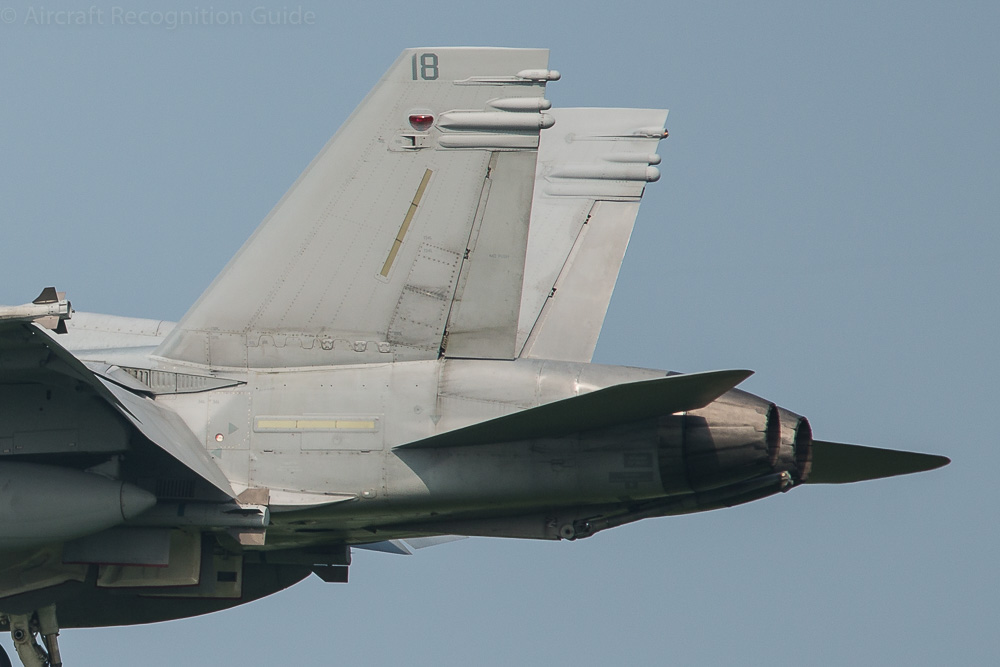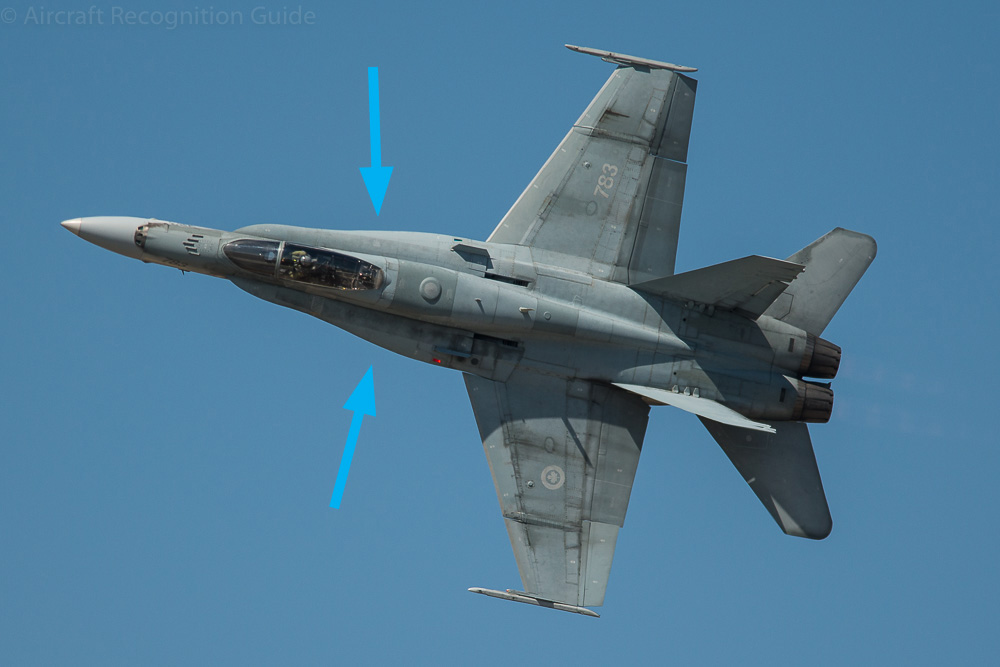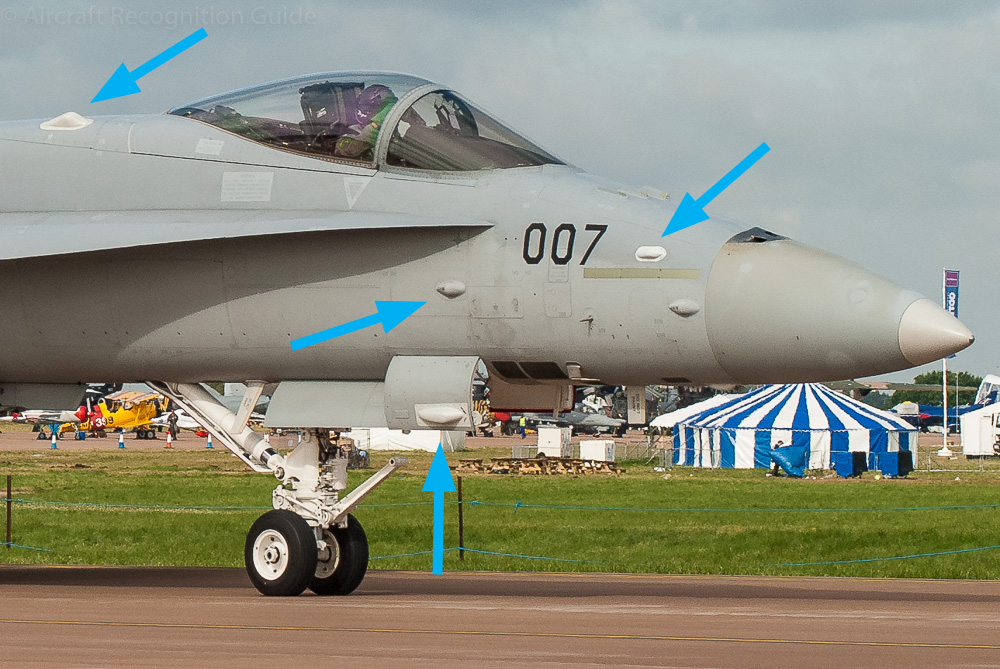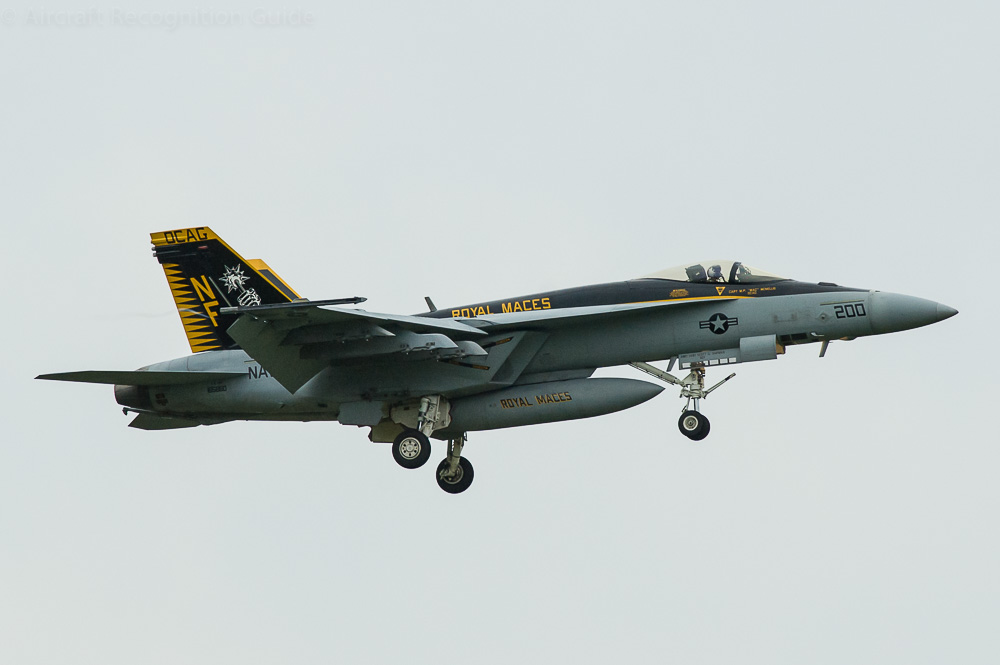
Boeing (McDonnell-Douglas) F/A-18 (Super) Hornet & EA-18G Growler
This fighter was at first developed from the Northrop YF-17 for the United States Navy. The latter aircraft had lost the competition from the YF-16 for a light weight fighter. Like many fighters the F/A-18 Hornet has double vertical stabilisers, which are in this case pointing outward a bit. They are located between the short swept wings and the horizontal stabilisers. The latter are placed at the very end of the fuselage, the next to the long exhaust pipes. This tail plane configuration is characteristic for the Hornet. Another recognition point are the leading edge root extensions of the wings, all the way up to the front of the canopy.
Leading edge extensions of the wings run up to the front of the canopy. The sturdy nose gear is a requirement for the carrier landings.
Different versions
The different versions of the F/A-18 can be identified by looking at
- the size of the aircraft
- the number of seats
- the shape of the air intakes
- the shape of the leading edge extensions
- the number of external antennas on nose and tail
- the presence of wing fences
F/A-18A Hornet
The first version is a single seat aircraft. It has O shaped, sort of oval air intakes under the wings. The leading edge extensions have a sort of S shape (see photo above). External antenna bumps are the way to recognise the original A model from upgrades and C model. There is one antenna on each side of the nose and three at the top end of each vertical stabiliser.
This version was sold to Spain, under the designation EF-18A, and Canada where it had military designation CF-188A.
The F/A-18A was the first version of the Hornet. Most have since been upgraded, but this is what they originally looked like. Actually this is a Canadian CF-188A.
The classic Hornet versions, A through D, have air intakes shaped as an O or zero, but some may call it oval. Note the wing fence above the intake, also typical for classic F/A-18s.
To distinguish the A model from upgrades and the C model you have to look at the nose. Here is one of the EF-18A, so an A version. It has one antenna bubble, next to the '8'.
The F/A-18A also has three antennas at the top of each vertical stabiliser, at the trailing edge: two long ones and one shorter.
F/A-18A+ Hornet
The upgraded version of the A model is designated F/A-18A+. Most differences are inside, but you can still recognise on the outside. On top of the nose, in front of the canopy, are four blade antennas on a row.
F/A-18B Hornet
The F/A-18B is the two seater version of the F/A-18A, so look for the longer canopy. For the rest they are externally the same. In Spain this version is known as EF-18B and in Canada CF-188B.
The F/A-18B has a longer canopy than the F/A-18A but is for the rest the same as the A model.
F/A-18C Hornet
With many upgrades in a single block update the F/A-18C was born. While externally largely the same as the F/A-18A there are many differences inside like another radar, avionics and the ability to launch new missiles.
On the outside the C model can be recognised by two additional antenna bumps behind the cockpit (on top of the fuselage), two additional bumps on each side of the nose (one just under the forward tip of the leading edge extensions and another above the one already on the nose), an antenna on the forward nose gear door and one on each fin in between the three already there. Two antennas under the intakes are not present anymore.
F/A-18D Hornet
Like the F/A-18B is the two seater version of the F/A-18A, the F/A-18D is the same for the F/A-18C. So look for the same antenna differences and a long canopy to identify an F/A-18D.
A part of the F/A-18Ds is fitted with a camera nose, known as Advanced Tactical Airborne Reconnaissance System (ATARS). It takes the place of the cannon.
F/A-18E Super Hornet
It is still designated F/A-18, but the E model differs a lot from the original A and C models. Firstly, the F/A-18E is much bigger, about 25%, hence the popular name is Super Hornet. Unofficially it is known as "Rhino" though. Especially the rectangular air intakes help easy identification. Furthermore the wing fences above the intakes are gone, as are many antenna bumps. FInally, the leading edge extensions have a different shape, being wider and without the S curve.
The F/A-18E at first looks just like an F/A-18A, as only side by side the difference in size is really visible. So you better look for the air intakes for identification.
Here is a better view on the rectangular air intakes of the Super Hornet, similar to those on the F-15. Also note there is no wing fence on top of the wing.
F/A-18F Super Hornet
While the F/A-18B and -D are mainly training versions of the single seat F/A-18A and -C, the F/A-18F is much more than just an advanced training version of the F/A-18E. It is indeed a two seater, but the back seat is occupied by a weapon systems officer instead of an instructor. As such, it replaced the F-14 Tomcat that had a similar crew. The F/A-18F has the same external characteristics as the E model, but with a longer canopy of course.
The F/A-18F is the two seat Super Hornet, also affectionally called "Rhino".
EA-18G Growler
The Super Hornet was not only the replacement for the A-6 Intruder, A-7 Corsair and F-14 Tomcat, but also the S-3 Viking and EA-6B Prowler. The latter was the electronic warfare version of the A-6 Intruder. That is probably why the EA-18G has received the similar name Growler, although in practice it is often called Grizzly to avoid confusion.
The Growler is externally largely the same as the F/A-18F, but with jamming pods at the wing tips and under the wings. There is also a plate on the nose, in front of the canopy, where the cannon is in (Super) Hornets. To improve stability Boeing added some aerodynamic improvements, of which the wing fences halfway the wings are most prominent. Other modifications include a smoother saw tooth in the leading edge (where the wings fold) and strips in front of the ailerons.
The most noticable differences between the F/A-18F and EA-18G are marked with arrows: electronic warfare equipment in nose and wing tips, and addition of wing fences and a smoother saw tooth. (photo US Navy/WikiMedia)
EF-18M
Like other countries Spain has upgraded the older EF-18As (based on F/A-18A) to make them more similar to the F/A-18C. These are designated EF-18M. They are different from the F/A-18A+ os the US Navy, as they do not have the four plate antennas in front of the canopy, but only a second antenna bump at the side of the nose, above the existing one.
Spain's upgraded F/A-18As are locally known as EF-18M. They can be recognised from the EF-18A by a second antenna bump at the side of the nose, seen here above the '1' of the code.
Confusion possible with
Northrop YF-17

Obviously the most similar aircraft to the F/A-18 Hornet is the Northrop YF-17, as this was the basis for the design. The YF-17 is a bit smaller than the Hornet, has a slightly differently shaped nose and leading edge extensions, and less tapered horizontal stabiliser, cut off straight at the tips.
Grumman F-14 Tomcat
The F-14 Tomcat also has vertical stabilisers tilted outward a bit and a sturdy landing gear suitable for carrier operations. The F-14 however has variable sweep wings and rectangular/diagonal air intakes in front of the wings.
Lockheed Martin F-22 Raptor
The F-22 Raptor also has two fins tilted outward. However, the air intakes are located more to the front of the fuselage. Also the wings are like a regular delta shape.






















